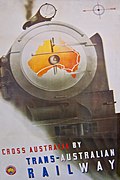- The Trans-Australian in 1924
- The Trans-Australian in 1938
- The Trans-Australian in 1951
- Poster advertising the Trans-Australian about 1940
- Post-war poster advertising the Trans-Australian in the final years of steam traction
- Poster advertising the introduction of diesel locomotives for the Trans-Australian in 1951
 | |
| Overview | |
|---|---|
| Status | Discontinued |
| Locale | South Australia Western Australia |
| First service | 1917 |
| Last service | 27 June 1991 |
| Former operator(s) | Commonwealth Railways (1917–1975) Australian National (1975–1991) Western Australian Government Railways (1969–1991) |
| Route | |
| Termini | Port Augusta / Port Pirie / Adelaide Kalgoorlie / Perth |
| Line(s) used | Adelaide-Port Augusta Trans-Australian Eastern Goldfields Eastern |
| Technical | |
| Track gauge | 1,435 mm (4 ft 8+1⁄2 in) |
The Trans-Australian (originally known as the Trans-Australian Express) was an Australian passenger train operated by the Commonwealth Railways initially between Port Augusta and Kalgoorlie on the Trans-Australian Railway line, and later extended west to Perth, and east to Port Pirie and Adelaide.





